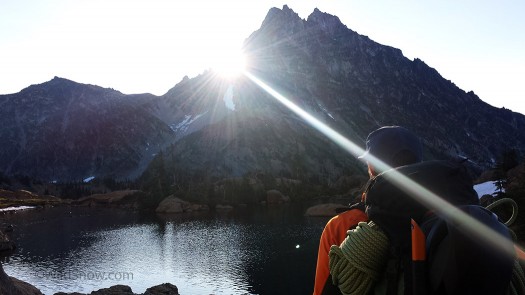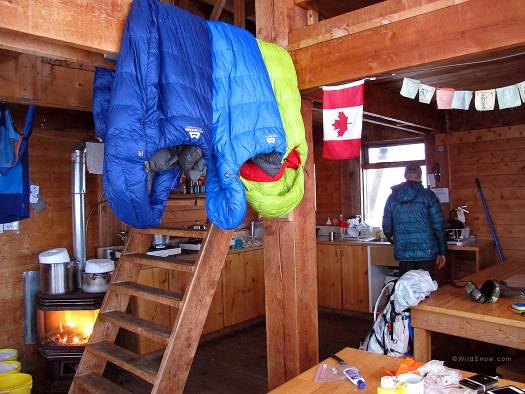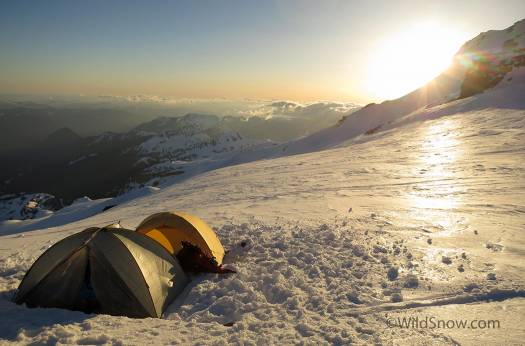Shop for Mountain Equipment sleeping bags.
I woke up shivering, soaking wet, without a sleeping bag, lying on a ledge high on the granite massif of Mt. Stuart here in the Cascades. It wasn’t an unplanned bivy, or an emergency. Instead, I was shivering in the name of light-weight, in my unwillingness to lug a heavy pack.
Two days previously, my climbing partner Kirk and I had weighed the decision of carrying our heavy sleeping bags up the route, as opposed to significantly lightening our packs. In the warm comfort of my living room it was an easy decision to not bring the sleeping bag, just an emergency blanket bivy sack. Up on the mountain, I wasn’t so sure. But I did know my standard 0 degree bag would have been overkill, so after that night I became convinced of the utility of a super-light summer bag.
This year I’ve been testing out the Mountain Equipment Helium 250 sleeping bag, one of ME’s lightest bags. The bag cuts weight in all possible ways, resulting in a fairly warm, 25 ounce unit. The packed bag is about the size of a small bread loaf. It is rated for a comfortable night’s sleep at 32F (0C), with an “extreme” rating of 5F (-15C). The Helium is stuffed with 280 grams of 750 fill down (check this out for details on down fill ratings). It also features a complex baffle system, and a tight cut (saves additional weight for a skinny guy like me; might not fit everyone).
This is the first bag I’ve owned that is rated for a higher temperature than 15F. I’ve always been wary of ultra-lightweight sleeping bags opting instead for the insurance of heavier, warmer bags. I often carry minimal warm clothes on overnight trips, reducing weight a bit to allow for a big warm bag. A good night’s sleep is important, and in the event of an emergency, having a super warm bag can be essential. However, a light, low insulation bag has its place.
I’ve had the Helium for a few months now and used it on a variety of trips. It’s perfect for hut trips, as it’s small, but still warm enough to stay cozy when the cabin gets a little colder in the middle of the night. Originally I thought the bag would be good for huts, warm summer trips, and little else. But on a few overnight trips this winter the little stuff-sack proved too tempting, and I took it instead of my heavy winter bag. With some careful techniques, the bag kept me sufficiently warm on a late winter and spring campouts. The bag is also small enough to easily carry while traveling, which I’ve found useful for couch-surfing, and unplanned nights in airports.
Of course, being a down bag, the Helium’s major weakness is water. On all my trips I’ve been careful to keep the bag as dry as possible, so moisture hasn’t been an issue. However, I’ve purposefully not brought it on trips without a tent, or with any chance of getting the bag wet. Also, the zipper, fabric, drawstring of the bag are lightweight and hence don’t seem all that durable. I’ve been careful with the bag and I tend to be fairly easy on my gear, so I haven’t had any issues so far. But it’s something to be aware of.
Other thoughts about water: Perhaps this type of sleeping bag should be constructed using water resistant down, which would make it safer for alpinism. Water resistant down can be less lofty, but once a bit of moisture comes into the picture the fluffiest down available starts to collapse anyway, and quickly gets dangerous. Further, perhaps the outer shell could be a super lightweight membrane type fabric that would be more water resistant. The Helium shell does repel water in a “bead off” fashion, but most certainly is not water resistant enough to block persistent wetting. (If I’d brought it on Mount Stuart, to be safe I probably would have used a waterproof, breathable bivy sack as well to protect it from moisture.)
I originally thought this sleeping bag would have limited use, only as a light bivy bag or for trips in warmer climes. However, since I got the Helium I’ve used it more than any other bag I have, and it’s not even deep summer yet! I’m looking forward to testing it out on summer climbing and hiking trips.
(WildSnow Editor’s note: A reliable source from Mountain Equipment tells us they offer another bag which is essentially the same as the Helium but more waterproof. The Matrix range of sleeping bags have both waterproof down (on the top of the bag) and Primaloft (on the bottom). The Matrix I is heavier than the Helium 250 (32oz vs 25oz) mainly because of the Primaloft on the bottom (which increases comfort when sitting on wet snow or other damp surfaces). The Matrix I is also slightly bulkier but Mountain Equipment designed it specifically for bivy use like Louie is referring to in the beginning of this review. According to Mountain Equipment, Matrix I could be used without a bivy sack on a misty belay ledge or in a drippy snow cave, but not if you’re not trying to sleep in a rainstorm.
Shop for Mountain Equipment sleeping bags.
Shop for 12 oz. waterproof breathable bivy sack here.
Louie Dawson earned his Bachelor Degree in Industrial Design from Western Washington University in 2014. When he’s not skiing Mount Baker or somewhere equally as snowy, he’s thinking about new products to make ski mountaineering more fun and safe.



